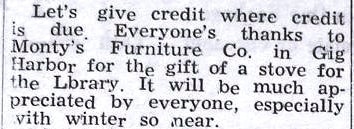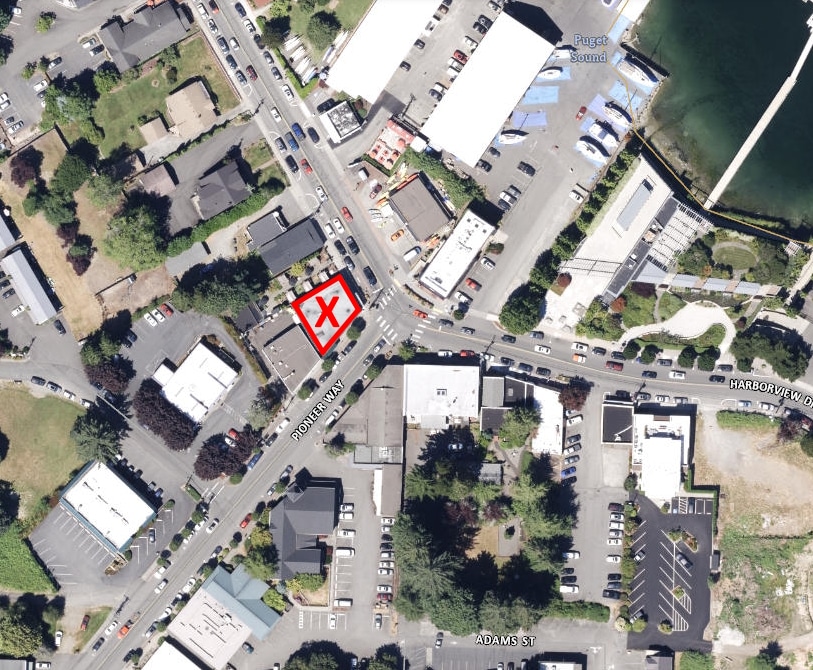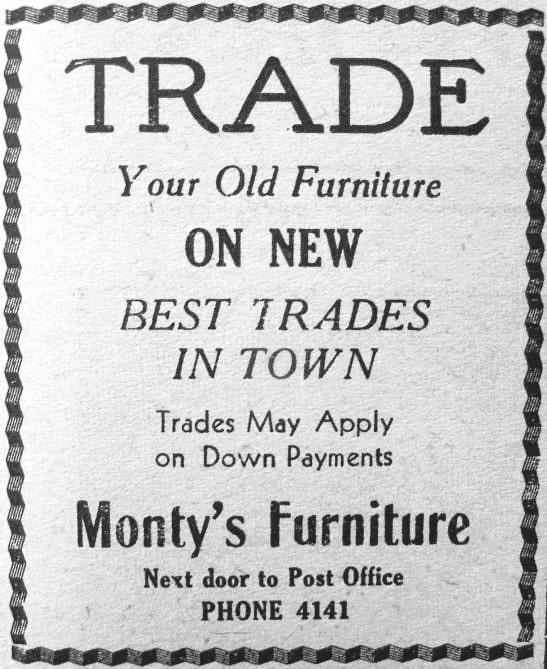Arts & Entertainment Community
Gig Harbor Now and Then | Sometimes, it seems like this is the only building in town
Old business
Our simple, easy question from the previous Gig Harbor Now and Then column was carefully designed to not siphon off any of the merriment of the holiday season. It was presented with this equally simple setup:
The Vaughn Library Hall, in Vaughn, on the Key Peninsula, is the oldest remaining community meeting hall on either the Key or Gig Harbor peninsulas. Throughout its 131-year existence, it has relied heavily on donated labor, materials, and money for upgrades, upkeep, and routine expenses. In 1952, Monty’s Furniture Company of Gig Harbor donated a stove to the library portion of the hall.

This clip, from the Vaughn News section of the October 24, 1952, issue of the Peninsula Gateway, was found at the Harbor History Museum.
Where in Gig Harbor was Monty’s Furniture store in 1952?
Answer: At the risk of becoming repetitive for the third time, the answer is the same as the one given on Dec. 18, 2023, concerning the location of Berkheimer’s first Gig Harbor store: At the southwest corner of the intersection of Pioneer Way and Harborview Drive in Gig Harbor, in the very same building now occupied by Heritage Distilling.
It’s also the same as the answer given on January 2, 2024, on the location of Safeway’s original store in Gig Harbor.
In addition, it’s the same as the one given on June 3, 2024, to the question of where the Gig Harbor post office was located in 1951.

In 1952, Monty’s Furniture Store shared the same building that was occupied by the Gig Harbor post office. Pierce County Assessor-Treasurer aerial base map.
The furniture store used the front part of the building (facing Harborview Drive), while the post office occupied the back.

This advertisement for Monty’s Furniture appeared in the October 24, 1952, Peninsula Gateway. It was found at the Harbor History Museum.
Note to self: It’s pretty slick when you can use the same location map four times.
New business
Today’s question of local history comes from an edited excerpt from “The Early Development of Gig Harbor, Washington” by Greg Spadoni, Copyright © 2021.
Adventures in spelling
Researching real estate documents and newspapers from the early days of Gig Harbor is slowed considerably — and sometimes stopped outright — by the frequent and unpredictable changes in spelling of certain people’s names. As examples, we’ll use the names Jeresich (Sam Jeresich, who started the commercial fishing industry in Gig Harbor) and Dorotich (Joseph Dorotich, best known for being a co-founder of the Millville neighborhood of Gig Harbor). They were among the earliest settlers of Gig Harbor, and, like several others, experienced wild variations in the spelling of their names.
Jeresich
On an 1877 deed, Samuel Jeresich was spelled Sarario Uhreisch. On another deed, in 1878, it was written as Savaria Jerissyicy. On later deeds the last name was spelled Guirichi (1881), Uhrisch (1887), Jerisich (1887) and Jeresich (1892). The 1880 Territorial census spelled it Gerisich.
When Sam Junior, who was deaf, attended the Washington School for Defective Youth in Vancouver, Wash., at the age of 14 in 1892, the spelling reverted to Jerisich.
Sam and Anna’s daughters — Melissa, Catherine, and Julia — spelled the last name Jerisigh in John Farragut’s will in 1895. Melissa’s marriage certificate in 1897 used the spelling Jerisitch, as did the will of Anna’s mother in 1901.
The General Land Office tract books recorded Sam’s homestead application with Jerrsick in 1900, yet spelled it Jeresich in a note on the line above.
To settle the matter, in 1903 Sam Jeresich signed an affidavit (with his mark) that stated he was the Savario Uhreisch on the 1877 deed (although that spelling of his first name, Savario, did not match Sarario, which was the spelling on the deed). The affidavit explained that a man named Long had drawn up the 1877 document, and to estimate the spelling of Jeresich’s name, asked him how it was pronounced in his native country. Sarario Uhreisch was the result. It further stated that Jeresich was the correct spelling, yet it has somehow since evolved to Jerisich, which is used today, a spelling first seen at least as early as 1887.
In the same affidavit, Jeresich stated that his longtime friend and neighbor John Farrague’s name was properly spelled Farrague rather than Farragut, although it no longer concerned Farrague, who was several years dead by that time.
Sam and Anna Jeresich’s son John, who, unlike his parents, could read and write, was asked to spell his last name while testifying under oath in Pierce County Superior Court on the afternoon of May 5, 1914. He replied with “J-e-r-e-s-i-c-h.” Jeresich, then, was the proper spelling for many years before Jerisich became the standard.
Dorotich
From the time Joseph Dorotich arrived in Gig Harbor in March 1877, his name evolved from Darovitch (1877) through Dotrich (1878 Pierce County Auditor’s Census), to today’s spelling of Dorotich in 1886, when he was living in Tacoma and operating a saloon for a couple years. Even after it had been established as Dorotich, it continued to be misspelled Doritich more often than not.
It appeared as Doratich in the first entry in the 1887 Polk Directory of Puget Sound, and Dorotich in the second.
After flirting with the modern spelling, it slipped to Dawvitch (1888 and 1914), Dorovitch (also 1888 and 1914), Doratige (1910 federal census) and Dawitch (1914 civil lawsuit), before reverting back to today’s spelling, Dorotich.
Although the matter seemed to be settled during the final years of his life, Joseph’s last name was corrupted into Dorodich on his death certificate in 1928. In what could be considered a final insult, the same document lists his place of burial as Gig Harbor Cemetery, though he is actually in the Artondale Cemetery. His wife Caroline’s death listing from 1937 is spelled Dorotish.
Why were there so many different spellings of single surnames on the early Peninsula?
Hint: it had nothing to do with autocomplete.
Item of Mystery
The Gig Harbor Now and Then Item of Mystery remains unidentified. Perhaps this is a good opportunity to review all the hints given so far. Titled Heap O’ Hints, the clues in the first group, from Gig Harbor Now and Then #38, are:
- Its size is completely misleading.
- This one is at least 78 years old, but there are newer ones in existence.
- The slight curvature is critically important in figuring out what it is.
- It’s a rather mundane item that has been rendered super cool by the passage of time.
- It has a direct link to the Harbor History Museum, although nobody there knows that.
- Virtually all of the people who find out what it is couldn’t care less. (Which is a piddle-poor attitude, by the way, because as we stated two sentences ago, time has rendered it super cool.)
- More than half the readers who started reading this week’s column have dropped out before getting this far. (OK, so that’s not a hint, but it’s an interesting fact, isn’t it?)
Hints from Gig Harbor Now and Then numbers 39, 40, and 41 are:
- While old, it’s not totally obsolete. There are some still being used today.
- The first few dozen of these on the Peninsula were in Burley, although they weren’t used there.
- Tonya Strickland figured it out in a matter of hours, but was disqualified by the Gig Harbor Now and Then Item of Mystery Rules Committee for being a Gig Harbor Now contributor.
- These things have been used all around the world, though probably only in North America today.
The new clue to the identity of the still unsolved Gig Harbor Now and Then Item of Mystery is: Though still being used in North America, they are not used every day.
Next time
In addition to the answer to today’s question of local history, next time we’ll introduce a new question that has to do with a fascinating topic. It’s a lead-in to one of the best Gig Harbor Now and Then columns we’ve ever had. Sure, it’s a low bar, but we clear it with ease.
— Greg Spadoni, December 30, 2024
Greg Spadoni of Olalla has had more access to local history than most life-long residents. During 25 years in road construction working for the Spadoni Brothers, his first cousins, twice removed, he traveled to every corner of the Gig Harbor and Key Peninsulas, taking note of many abandoned buildings, overgrown farms, and roads that no longer had a destination. Through his current association with the Harbor History Museum in Gig Harbor as the unofficial Chief (and only) Assistant to Linda McCowen, the Museum’s primary photo archive volunteer, he regularly studies the area’s largest collection of visual history. Combined with the print history available at the Museum and online, he has uncovered countless stories of long-forgotten local people and events.

